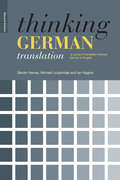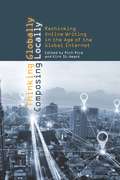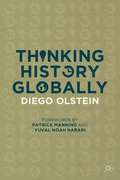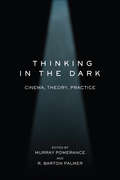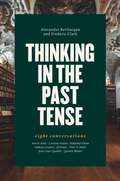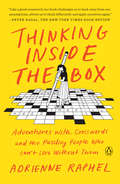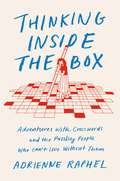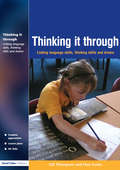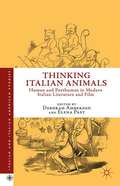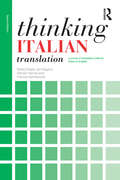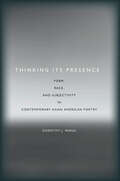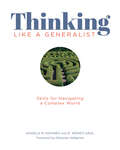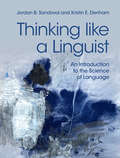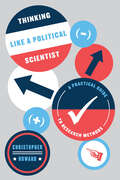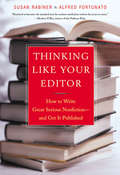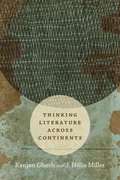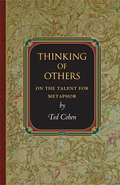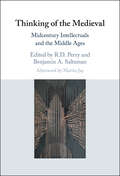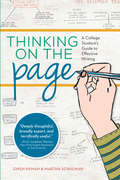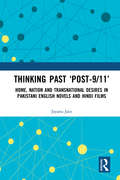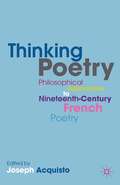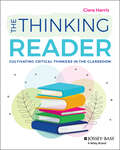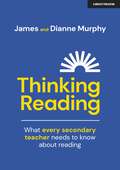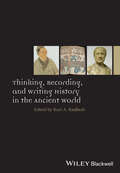- Table View
- List View
Thinking German Translation: Teacher's Handbook (Thinking Translation)
by Ian Higgins Sandor Hervey Michael LoughridgeThis is a comprehensive practical course in translation for advanced students of German, which focuses on improving translation quality whilst clarifying the theoretical issues involved. This second edition brings the course up-to-date, and has been fully reworked to give clearer explanations of key terms and include revised chapters on genre, compensation and revision and editing. Based on detailed analysis of translation problems, Thinking German Translation features new material taken from a wide range of sources, including: business and politics press and publicity engineering tourism literary and consumer-oriented texts. Addressing a variety of translation issues such as cultural difference, register and dialect, Thinking German Translation is essential reading for all students wishing to perfect their translation skills. It is also an excellent foundation for those considering a career in translation. Further resources, including a free teacher's handbook for the course, are available on the companion website at http://cw.routledge.com/textbooks/0415341469/resources/default.asp
Thinking Globally, Composing Locally: Rethinking Online Writing in the Age of the Global Internet (G - Reference, Information And Interdisciplinary Subjects Ser.)
by Rich RiceThinking Globally, Composing Locally explores how writing and its pedagogy should adapt to the ever-expanding environment of international online communication. Communication to a global audience presents a number of new challenges; writers seeking to connect with individuals from many different cultures must rethink their concept of audience. They must also prepare to address friction that may arise from cross-cultural rhetorical situations, variation in available technology and in access between interlocutors, and disparate legal environments. The volume offers a pedagogical framework that addresses three interconnected and overarching objectives: using online media to contact audiences from other cultures to share ideas; presenting ideas in a manner that invites audiences from other cultures to recognize, understand, and convey or act upon them; and composing ideas to connect with global audiences to engage in ongoing and meaningful exchanges via online media. Chapters explore a diverse range of pedagogical techniques, including digital notebooks designed to create a space for active dialogic and multicultural inquiry, experience mapping to identify communication disruption points in international customer service, and online forums used in global distance education. Thinking Globally, Composing Locally will prove an invaluable resource for instructors seeking to address the many exigencies of online writing situations in global environments. Contributors: Suzanne Blum Malley, Katherine Bridgman, Maury Elizabeth Brown, Kaitlin Clinnin, Cynthia Davidson, Susan Delagrange, Scott Lloyd Dewitt, Amber Engelson, Kay Halasek, Lavinia Hirsu, Daniel Hocutt, Vassiliki Kourbani, Tika Lamsal, Liz Lane, Ben Lauren, J. C. Lee, Ben McCorkle, Jen Michaels, Minh-Tam Nguyen, Beau S. Pihlaja, Mª Pilar Milagros, Cynthia L. Selfe, Heather Turner, Don Unger, Josephine Walwema
Thinking History Globally
by Diego OlsteinThinking History Globally means thinking about the past and the present beyond national borders, language barriers, and enclosed regions. There are four thinking strategies to gain global perspectives: comparing, connecting, conceptualizing, and contextualizing. Comparing is about contrasting between several cases and drawing new conclusions. Connecting is tracking the interdependences between cases and assessing their importance. Conceptualizing is recognizing that developments in one or several cases belong within a larger recurring pattern. Contextualizing is making sense of one case amidst developments world-wide. This book offers a practical guide into these strategies of thinking by applying them to multiple historical cases, ranging from the first civilizations and up to the First World War. While doing that, Olstein also presents the twelve branches of history that outstand in the application of these four strategies and in thinking history globally: comparative, relational, international, transnational, oceanic, global, world, and big histories, historical sociology, civilizational analysis, world-system approach, and history of globalization.
Thinking in the Dark: Cinema, Theory, Practice
by Murray Pomerance R. Barton Palmer Colin Williamson Steven Rybin Steven Woodward Jeremy Blatter Professor William Rothman Tom Gunning Dudley Andrew Gilberto Perez Professor Kristen Hatch Dominic Lennard Alex Clayton Johannes Von Moltke Nathan Holmes Will Scheibel Jonah Corne Professor William Brown Daniel Morgan Professor Matthew Solomon Sarah Keller Tom ConleyToday's film scholars draw from a dizzying range of theoretical perspectives--they're just as likely to cite philosopher Gilles Deleuze as they are to quote classic film theorist André Bazin. To students first encountering them, these theoretical lenses for viewing film can seem exhilarating, but also overwhelming. Thinking in the Dark introduces readers to twenty-one key theorists whose work has made a great impact on film scholarship today, including Rudolf Arnheim, Sergei Eisenstein, Michel Foucault, Siegfried Kracauer, and Judith Butler. Rather than just discussing each theorist's ideas in the abstract, the book shows how those concepts might be applied when interpreting specific films by including an analysis of both a classic film and a contemporary one. It thus demonstrates how theory can help us better appreciate films from all eras and genres: from Hugo to Vertigo, from City Lights to Sunset Blvd., and from Young Mr. Lincoln to A.I. and Wall-E. The volume's contributors are all experts on their chosen theorist's work and, furthermore, are skilled at explaining that thinker's key ideas and terms to readers who are not yet familiar with them. Thinking in the Dark is not only a valuable resource for teachers and students of film, it's also a fun read, one that teaches us all how to view familiar films through new eyes. Theorists examined in this volume are: Rudolf Arnheim, Béla Balázs, Roland Barthes, André Bazin, Walter Benjamin, Judith Butler, Stanley Cavell, Michel Chion, Gilles Deleuze, Jean Douchet, Sergei Eisenstein, Jean Epstein, Michel Foucault, Siegfried Kracauer, Jacques Lacan, Vachel Lindsay, Christian Metz, Hugo Münsterberg, V. F. Perkins, Jacques Rancière, and Jean Rouch.
Thinking in the Past Tense: Eight Conversations
by Alexander Bevilacqua Frederic ClarkIf the vibrancy on display in Thinking in the Past Tense is any indication, the study of intellectual history is enjoying an unusually fertile period in both Europe and North America. This collection of conversations with leading scholars brims with insights from such diverse fields as the history of science, the reception of classical antiquity, book history, global philology, and the study of material culture. The eight practitioners interviewed here specialize in the study of the early modern period (c. 1400–1800), for the last forty years a crucial laboratory for testing new methods in intellectual history. The lively conversations don’t simply reveal these scholars’ depth and breadth of thought; they also disclose the kind of trade secrets that historians rarely elucidate in print. Thinking in the Past Tense offers students and professionals alike a rare tactile understanding of the practice of intellectual history. Here is a collectively drawn portrait of the historian’s craft today.
Thinking Inside the Box: Adventures with Crosswords and the Puzzling People Who Can't Live Without Them
by Adrienne RaphelA delightful, erudite, and immersive exploration of the crossword puzzle and its fascinating history by a brilliant young writerAlmost as soon as it appeared, the crossword puzzle had already become indispensable to our lives. Invented practically by accident in 1913, when a newspaper editor at the New York World was casting around for something to fill empty column space, it became a roaring commercial success practically overnight. Ever since then, the humble puzzle--consisting of a grid of blank squares in which solvers write answers in response to clues--has been an essential ingredient of any newspaper worth its salt. The puzzle's daily devotees include everyone from subway riders looking to pass the time to cultural icons such as Martha Stewart, Bill Clinton, and Yo-Yo Ma. Today, its popularity is greater than ever, even as the media world has undergone a perilous digital transformation. But why, exactly, are the crossword's satisfactions so sweet that it is a fixture of breakfast tables, nightstands, and commutes, and has even given rise to competitive crossword tournaments? There are mysteries beyond the clues.Blending first-person reporting from the world of crosswords with a delightful telling of its rich literary history, Adrienne Raphel dives into the secrets of this classic pastime. At the annual American Crossword Puzzle Tournament, she rubs shoulders with elite solvers of the world; aboard a crossword- themed cruise, she picks the brains of the enthusiasts whose idea of a good time is a week on the high seas with nothing but crosswords to do; and, visiting the home and office of Will Shortz, New York Times crossword editor and NPR's official "Puzzlemaster," she goes behind the scenes to see for herself how America''s gold standard of puzzles is made.As ingenious as it is fun, Thinking Inside the Box is a love letter not just to the abiding power of the crossword but to the infinite joys and playful possibilities of language itself. This book will be a treat for die-hard cruciverbalists and first-time solvers alike.
Thinking Inside the Box: Adventures with Crosswords and the Puzzling People Who Can't Live Without Them
by Adrienne Raphel'Beautifully researched account, full of humour and personal insight'David Crystal, author of Making Sense: The Glamorous Story of English Grammar'A witty, wise, and wonderfully weird journey that will change the way you think . . . This book is a delight'Bianca Bosker, author of Cork Dork: A Wine-Fueled Adventure Among the Obsessive Sommeliers, Big Bottle Hunters, and Rogue Scientists Who Taught Me to Live for Taste'Delightfully engrossing, charmingly and enthusiastically well-written history of the crossword puzzle' Benjamin Dreyer, author of Dreyer's English: An Utterly Correct Guide to Clarity and Style 'Full of treasures, surprises and fun . . . richly bringing to life the quirky, obsessive, fascinating characters in the crossword world' Mary Pilon, author of The Monopolists: Obsession, Fury, and the Scandal Behind the World's Favorite Board Game 'A gold mine of revelations. If there is a pantheon of cruciverbalist scholars, Adrienne Raphel has established herself squarely within it'Mary Norris, author of Between You & Me: Confessions of a Comma QueenEqual parts ingenious and fun, Thinking Inside the Box is a love letter to the infinite joys and playful possibilities of language, a treat for die-hard cruciverbalists and first-time crossword solvers alike.The crossword is a feature of the modern world, inspiring daily devotion and obsession from millions. It was invented in 1913, almost by accident, when an editor at the New York World was casting around for something to fill some empty column space for that year's Christmas edition. Almost overnight, crosswords became a phenomenal commercial success, and have been an essential ingredient of any newspaper worth its salt since then. Indeed, paradoxically, the popularity of crosswords has never been greater, even as the world of media and newspapers, the crossword's natural habitat, has undergone a dramatic digital transformation. But why, exactly, are the satisfactions of a crossword so sweet that over the decades they have become a fixture of breakfast tables, bedside tables and commutes, and even given rise to competitive crossword tournaments?Blending first-person reporting from the world of crosswords with a delightful telling of the crossword's rich literary history, Adrienne Raphel dives into the secrets of this classic pastime. At the annual American Crossword Puzzle Tournament, she rubs shoulders with elite solvers from all over the world, doing her level best to hold her own; aboard a crossword-themed cruise she picks the brains of the enthusiasts whose idea of a good time is a week on the high seas with nothing to do but crosswords; and, visiting the home and office of Will Shortz, New York Times crossword puzzle editor and US National Public Radio's official Puzzlemaster, she goes behind the scenes to see for herself how the world's gold standard of puzzles is made.
Thinking it Through: Developing Thinking and Language Skills Through Drama Activities
by Gill Thompson Huw EvansTeaching should be exciting and creative but an overcrowded curriculum can make this hard for teachers to achieve. Help is at hand with these literacy and numeracy lesson plans that also cover language development, thinking skills, and drama. Thinking it Through allows teachers to customize lesson plans to meet their own needs using the book's accompanying CD as well as assess pupils language abilty with handy photocopiable assessment worksheets. The book will help each child reach their full potential regardless of ability using ideas for differentiation and extension and structure lessons according to national curriculum objectives.
Thinking Italian Animals
by Deborah Amberson Elena PastSituated on the cutting edge of scholarship in a variety of fields, this bracing volume draws together essays on Italian writers and filmmakers whose work engages with nonhuman animal subjectivity. Analyzing works from unification to the present, they address three major strands of current philosophical thought: the perceived borders between man and nonhuman animals, historical and fictional crises facing humanity, and human entanglement with the nonhuman and material world. These essays are driven by philosophical, theoretical, and ethical questions that interrogate Italian cultural production in provocative new ways, and their analysis has implications not simply for Italianists, but for a range of scholars doing work within cross-disciplinary fields such as animal studies, ecocriticism, and posthuman philosophy.
Thinking Italian Translation: A course in translation method: Italian to English (Thinking Translation)
by Stella Cragie Ian Higgins Sándor Hervey Patrizia GambarottaThinking Italian Translation is an indispensable course for students who want to develop their Italian to English translation skills. This new edition includes: up-to-date examples and new source texts from a variety of genres, from journalistic to technical. a brand new section on professionalism and the translation market The course is practical, addressing key issues for translators such as cultural differences, genre, and revision and editing. At the same time, it clearly defines translation theories. Thinking Italian Translation is key reading for advanced students wishing to perfect their language skills or considering a career in translation.
Thinking Its Presence: Form, Race, and Subjectivity in Contemporary Asian American Poetry
by Dorothy J. WangWhen will American poetry and poetics stop viewing poetry by racialized persons as a secondary subject within the field? Dorothy J. Wang makes an impassioned case that now is the time. Thinking Its Presence calls for a radical rethinking of how American poetry is being read today, offering its own reading as a roadmap. While focusing on the work of five contemporary Asian American poets#151;Li-Young Lee, Marilyn Chin, John Yau, Mei-mei Berssenbrugge, and Pamela Lu#151;the book contends that aesthetic forms are inseparable from social, political, and historical contexts in the writing and reception of all poetry. Wang questions the tendency of critics and academics alike to occlude the role of race in their discussions of the American poetic tradition and casts a harsh light on the double standard they apply in reading poems by poets who are racial minorities. This is the first sustained study of the formal properties in Asian American poetry across a range of aesthetic styles, from traditional lyric to avant-garde. Wang argues with conviction that critics should read minority poetry with the same attention to language and form that they bring to their analyses of writing by white poets.
Thinking Like a Generalist: Skills for Navigating a Complex World
by Angela Kohnen Wendy SaulWhat can we teach kids today that will have utility ten or fifteen years from now? Angela Kohnen and Wendy Saul propose an approach to information literacy that goes beyond the teaching of discreet, easily outdated skills. Instead they use activity to help students build identities as curious individuals empowered to ask their own questions and able to navigate their information-filled world in pursuit of credible answers. A generalist is curious, open-minded, skeptical, and persistent in their quest for information. Thinking Like a Generalist: Skills for Navigating a Complex World demonstrates what it means to take a generalist stance in instruction and provides a set of teaching tools to be able to pass those skills to students'sskills that will transfer beyond the walls of the classroom. Inside you'll find the following: A thorough introduction to what it means to be a generalist, and how to develop the practices and tools that help generalists navigate the world we live inA focus on the teacher becoming a generalist and tips for modeling those practices in the classroomDetailed instructions on how to write a unit of study that emphasizes generalist literacy skills and includes an overview and examples of five different unitsHow to use the authors' read-aloud-think-aloud strategy to orient students to generalist tools and practicesThe ideas, strategies, and examples Thinking Like a Generalist will give you the tools to think like a generalist and then pass that knowledge on to your students, guiding them to become inquisitive, lifelong learners and preparing them for a future that we can't yet imagine.
Thinking like a Linguist: An Introduction to the Science of Language
by Jordan B. Sandoval Kristin E. DenhamThis is an engaging introduction to the study of language for undergraduate or beginning graduate students, aimed especially at those who would like to continue further linguistic study. It introduces students to analytical thinking about language, but goes beyond existing texts to show what it means to think like a scientist about language, through the exploration of data and interactive problem sets. A key feature of this text is its flexibility. With its focus on foundational areas of linguistics and scientific analysis, it can be used in a variety of course types, with instructors using it alongside other information or texts as appropriate for their own courses of study. The text can also serve as a supplementary text in other related fields (Speech and Hearing Sciences, Psychology, Education, Computer Science, Anthropology, and others) to help learners in these areas better understand how linguists think about and work with language data. No prerequisites are necessary. While each chapter often references content from the others, the three central chapters on sound, structure, and meaning, may be used in any order.
Thinking Like a Political Scientist: A Practical Guide to Research Methods (Chicago Guides to Writing, Editing, and Publishing)
by Christopher HowardEach year, tens of thousands of students who are interested in politics go through a rite of passage: they take a course in research methods. Many find the subject to be boring or confusing, and with good reason. Most of the standard books on research methods fail to highlight the most important concepts and questions. Instead, they brim with dry technical definitions and focus heavily on statistical analysis, slighting other valuable methods. This approach not only dulls potential enjoyment of the course, but prevents students from mastering the skills they need to engage more directly and meaningfully with a wide variety of research. With wit and practical wisdom, Christopher Howard draws on more than a decade of experience teaching research methods to transform a typically dreary subject and teach budding political scientists the critical skills they need to read published research more effectively and produce better research of their own. The first part of the book is devoted to asking three fundamental questions in political science: What happened? Why? Who cares? In the second section, Howard demonstrates how to answer these questions by choosing an appropriate research design, selecting cases, and working with numbers and written documents as evidence. Drawing on examples from American and comparative politics, international relations, and public policy, Thinking Like a Political Scientist highlights the most common challenges that political scientists routinely face, and each chapter concludes with exercises so that students can practice dealing with those challenges.
Thinking Like Your Editor: How to Write Great Serious Nonfiction and Get It Published
by Susan Rabiner Alfred FortunatoDistilled wisdom from two publishing pros for every serious nonfiction author in search of big commercial success. Over 50,000 books are published in America each year, the vast majority nonfiction. Even so, many writers are stymied in getting their books published, never mind gaining significant attention for their ideas--and substantial sales. This is the book editors have been recommending to would-be authors. Filled with trade secrets, Thinking Like Your Editor explains: * why every proposal should ask and answer five key questions; * how to tailor academic writing to a general reader, without losing ideas or dumbing down your work; * how to write a proposal that editors cannot ignore; * why the most important chapter is your introduction; * why "simple structure, complex ideas" is the mantra for creating serious nonfiction; * why smart nonfiction editors regularly reject great writing but find new arguments irresistible. Whatever the topic, from history to business, science to philosophy, law, or gender studies, this book is vital to every serious nonfiction writer.
Thinking Literature across Continents
by Ranjan Ghosh J. Hillis MillerThinking Literature across Continents finds Ranjan Ghosh and J. Hillis Miller--two thinkers from different continents, cultures, training, and critical perspectives--debating and reflecting upon what literature is and why it matters. Ghosh and Miller do not attempt to formulate a joint theory of literature; rather, they allow their different backgrounds and lively disagreements to stimulate generative dialogue on poetry, world literature, pedagogy, and the ethics of literature. Addressing a varied literary context ranging from Victorian literature, Chinese literary criticism and philosophy, and continental philosophy to Sanskrit poetics and modern European literature, Ghosh offers a transnational theory of literature while Miller emphasizes the need to account for what a text says and how it says it. Thinking Literature across Continents highlights two minds continually discovering new paths of communication and two literary and cultural traditions intersecting in productive and compelling ways.
Thinking of Others: On the Talent for Metaphor (Princeton Monographs in Philosophy #37)
by Ted CohenIn Thinking of Others, Ted Cohen argues that the ability to imagine oneself as another person is an indispensable human capacity--as essential to moral awareness as it is to literary appreciation--and that this talent for identification is the same as the talent for metaphor. To be able to see oneself as someone else, whether the someone else is a real person or a fictional character, is to exercise the ability to deal with metaphor and other figurative language. The underlying faculty, Cohen argues, is the same--simply the ability to think of one thing as another when it plainly is not. In an engaging style, Cohen explores this idea by examining various occasions for identifying with others, including reading fiction, enjoying sports, making moral arguments, estimating one's future self, and imagining how one appears to others. Using many literary examples, Cohen argues that we can engage with fictional characters just as intensely as we do with real people, and he looks at some of the ways literature itself takes up the question of interpersonal identification and understanding. An original meditation on the necessity of imagination to moral and aesthetic life, Thinking of Others is an important contribution to philosophy and literary theory.
Thinking of the Medieval: Midcentury Intellectuals and the Middle Ages
by Perry Benjamin A. SaltzmanThe mid-twentieth century gave rise to a rich array of new approaches to the study of the Middle Ages by both professional medievalists and those more well-known from other pursuits, many of whom continue to exert their influence over politics, art, and history today. Attending to the work of a diverse and transnational group of intellectuals – Hannah Arendt, Erich Auerbach, W. E. B. Du Bois, Frantz Fanon, Erwin Panofsky, Simone Weil, among others – the essays in this volume shed light on these thinkers in relation to one another and on the persistence of their legacies in our own time. This interdisciplinary collection gives us a fuller and clearer sense of how these figures made some of their most enduring contributions with medieval culture in mind. Thinking of the Medieval is a timely reminder of just how vital the Middle Ages have been in shaping modern thought.
Thinking on the Page: A College Student's Guide to Effective Writing
by Gwen Hyman Martha SchulmanTake Charge of Your Writing--and Dazzle Your Instructors! It can be a challenge to achieve writing excellence, but it doesn't have to be mysterious, and it's definitely not impossible. To present powerful ideas effectively in your college essays, you need to break away from rigid rules and structures and start thinking on the page. With this book, you'll learn how to actively engage with a text, analyze it, draw informed conclusions, and then make solid claims about what you have observed. Thinking on the Page will also help you: Think critically about what you're reading and draw questions and ideas directly from the text Approach your essay as a story rather than a formula Work through your ideas by graphing, listing, charting, and drawing Incorporate relevant outside research Edit your final essay and polish it to perfection Whether you're in college or high school, you need to communicate your ideas effectively through writing. Thinking on the Page provides innovative tools tailored to the way you learn and write, enabling you to produce thoughtful, analytical, and meaningful work, both in school and beyond.
Thinking Past ‘Post-9/11’: Home, Nation and Transnational Desires in Pakistani English Novels and Hindi Films
by Jayana JainThis book offers new ways of constellating the literary and cinematic delineations of Indian and Pakistani Muslim diasporic and migrant trajectories narrated in the two decades after the 9/11 attacks. Focusing on four Pakistani English novels and four Indian Hindi films, it examines the aesthetic complexities of staging the historical nexus of global conflicts and unravels the multiple layers of discourses underlying the notions of diaspora, citizenship, nation and home. It scrutinises the “flirtatious” nature of transnational desires and their role in building glocal safety valves for inclusion and archiving a planetary vision of trauma. It also provides a fresh perspective on the role of Pakistani English novels and mainstream Hindi films in tracing the multiple origins and shifts in national xenophobic practices, and negotiating multiple modalities of political and cultural belonging. It discusses various books and films including The Reluctant Fundamentalist, Burnt Shadows, My Name is Khan, New York, Exit West, Home Fire, AirLift and Tiger Zinda Hai. In light of the twentieth anniversary of 9/11 attacks, current debates on terror, war, paranoid national imaginaries and the suspicion towards migratory movements of refugees, this book makes a significant contribution to the interdisciplinary debates on border controls and human precarity. A crucial work in transnational and diaspora criticism, it will be of great interest to researchers of literature and culture studies, media studies, politics, film studies, and South Asian studies.
Thinking Poetry: Philosophical Approaches to Nineteenth-Century French Poetry
by Joseph AcquistoThis volume of essays seeks to establish a dialogue between poetry and philosophy where each could be said to read the other and announces important new paths for a reinvigorated study of lyric poetry in the decades to come.
The Thinking Reader: Cultivating Critical Thinkers in the Classroom
by Ciera HarrisConcepts, lesson plans, and strategies for making reading lessons work The Thinking Reader: Cultivating Critical Thinkers in the Classroom is the frazzled teacher's guide to setting up any grade 2-4 classroom for reading success. You won't find any busywork, condescending lectures, or boring worksheets in this book. Instead, you'll learn flexible reading strategies to blend into your lessons at the start of the school year that will support your students for years to come. This book also debunks old-school ideas about reading instruction and explains the concepts that you'll need to know as you help students build a foundation for their future as readers. Former elementary teacher and instructional coach Ciera Harris has achieved remarkable, replicable results with young readers, not with a rigid system or program, but with a new approach to thinking about reading. In this book, you'll learn why it makes sense to go beyond all the lessons of phonics, fluency, and vocabulary by making reading personal to each student. This easy-to-use approach has helped teachers across the country create a culture of reading within their classrooms, so students—even those that struggle the most with reading—can start view themselves as readers. Help students learn based on what interests them, as individuals, and watch budding readers bloom. Discover why reading is not a series of decoding skills, but a personal, powerful act of thinking Learn the steps to setting up your classroom for reading success at the beginning of the year Get engaging lesson plans and techniques for implementing primary reading strategies like schema, asking questions, metacognition, and so much more Overcome common roadblocks, including student resistance to reading With The Thinking Reader, elementary school teachers in grades 2-4 can build the ultimate framework for reading success.
Thinking Reading: What every secondary teacher needs to know about reading
by Dianne Murphy James MurphyDespite the efforts of teachers and educators, every year secondary schools across the English-speaking world turn out millions of functionally illiterate leavers. The costs in human misery and in wasted productivity are catastrophic. What can schools do to prevent this situation? In this highly accessible book James and Dianne Murphy combine more than 50 years of experience to provide teachers with a thorough, easy to use introduction to the extensive research on reading and its effects on student achievement. Drawing on the work of experts from around the world, the authors explore how we learn to read, how the many myths and misconceptions around reading developed, and why they continue to persist.Building on these foundations chapters go on to examine how the general secondary school classroom can support all levels of reading more effectively, regardless of subject; how school leaders can ensure that their systems, practices and school culture deliver the very best literacy provision for all students; and what it takes to ensure that a racing intervention aimed at adolescent struggling readers is truly effective. The overall message of this books is one of great optimism: the authors demonstrate that the right of every child to learn to read is entirely achievable if schools employ the best research-driven practice.
Thinking Reading: What every secondary teacher needs to know about reading
by Dianne Murphy James MurphyDespite the efforts of teachers and educators, every year secondary schools across the English-speaking world turn out millions of functionally illiterate leavers. The costs in human misery and in wasted productivity are catastrophic. What can schools do to prevent this situation? In this highly accessible book James and Dianne Murphy combine more than 50 years of experience to provide teachers with a thorough, easy to use introduction to the extensive research on reading and its effects on student achievement. Drawing on the work of experts from around the world, the authors explore how we learn to read, how the many myths and misconceptions around reading developed, and why they continue to persist.Building on these foundations chapters go on to examine how the general secondary school classroom can support all levels of reading more effectively, regardless of subject; how school leaders can ensure that their systems, practices and school culture deliver the very best literacy provision for all students; and what it takes to ensure that a racing intervention aimed at adolescent struggling readers is truly effective. The overall message of this books is one of great optimism: the authors demonstrate that the right of every child to learn to read is entirely achievable if schools employ the best research-driven practice.
Thinking, Recording, and Writing History in the Ancient World (Ancient World: Comparative Histories #8)
by Kurt A. RaaflaubThinking, Recording, and Writing History in the Ancient World presents a cross-cultural comparison of the ways in which ancient civilizations thought about the past and recorded their own histories. Written by an international group of scholars working in many disciplines Truly cross-cultural, covering historical thinking and writing in ancient or early cultures across in East, South, and West Asia, the Mediterranean, and the Americas Includes historiography shaped by religious perspectives, including Judaism, early Christianity, Islam, and Buddhism
